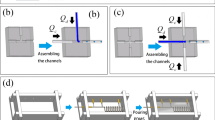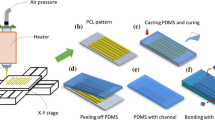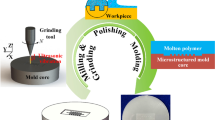Abstract
Micro-flow channel is basic functional component of microfluidic chip, and every step-forward of its construction technique has been receiving concern all over the world. This article presents a notcomplicated but flexible method for fabrication of micro-flow channels. This method mainly utilizes the conventional molding capability of polydimethylsiloxane (PDMS) and widespread commercial microwires as templates. We have fabricated out some conventional types of microchannels with different topological shapes, as examples for the demonstration of this flexible fabrication route which was not dependent on the stringent demands of photolithographical or microelectromechanical system (MEMS) techniques. The smooth surface, high-intensity, and high flexibility of the wires made it possible to create many types of topological structures of the two-dimensional or three-dimensional microchannel or channel array. The geometric shape of the cross-section of thus forming microchannel in PDMS was the negative of that of embedded-in microwire, in high-fidelity if suitable measures were taken. Moreover, such a microchannel fabrication process can easily integrate the conductivity and low resistivity of the metal wire to create micro-flow devices that are suitable for the electromagnetic control of liquid or the temperature regulation in the microchannel. Furthermore some preliminary optical analysis was provided for the observation of thus forming rounded microchannel. Based on this molding strategy, we even made some prototypes for functional microflow application, such as microsolenoids chip and temperature control gadgets. And an experiment of forming a droplet in the cross channel further confirmed the feasibility and applicability of this flexible microchannel forming technique.
Similar content being viewed by others
References
Whitesides G M. The origins and the future of microfluidics. Nature, 2006, 442(7101): 368–373
Chen C, Hirdes D, Folch A. Gray-scale photolithography using microfluidic photomasks. Proc Natl Acad Sci USA, 2003, 100(4): 1499–1504
Ikuta K, Hirowatiri H, Ogata Y. Three dimensional micro integrated fluid systems (MIFS) fabricated by stereo lithography. Pro IEEE MEMS (MEMS’94), Oiso, Japan, 1994 Jan 25–28. 1–6
Bloomstein T M, Ehrlich D J. Laser-chemical three-dimensional writing for microelectromechanics and application to standard-cell microfluidics. J Vac Sci Technol. B, 1992, 10(6): 2671–2674
Gonzalez C, Smith R L, Howitt D G, Microjoinery: concept, definition, and application to microsystem development. Sens & Actu. A, 1998, 66(1–3): 315–332
Jo B H, Van Lerberghe L M, Motsegood K M, Three-dimensional micro-channel fabrication in polydimethylsiloxane (PDMS) elastomer. J MEMS, 2000, 9(1): 76–81
Jiang J H. Biomedical Microsystem Technology and Its Application (in Chinese). Beijing: Chemical Industry Press, 2006. 24
Xia Y, Whitesides G M. Soft lithography. Angew Chem Int Ed, 1998, 37(28): 550–575
Kumar A, Whitesides G M. Formation of microstamped patterns on surfaces and derivative articles. U.S. Patent, 5512131, 1997-09–18
Chen C S, Mrksich M, Huang S, Geometric control of cell life and death. Science, 1997, 276(5317): 1425–1428
Bernard A, Delamarche E, Schmid H, Printing patterns of proteins. Langmuir, 1998, 14(9): 2225–2229
Jeon N L, Choi I S, Xu B, Large-area patterning by vacuum-assisted micromolding. Adv Mater, 1999, 11(11): 946–949
Delamarche E, Bernard A, Schmid H, Patterned delivery of immunoglobulins to surfaces using microfluidic networks. Science, 1997, 276(5313): 779–781
Delamarche E, Bernard A, Schmid H, Microfluidic networks for chemical patterning of substrate: Design and application to bioassays. J Am Chem Soc, 1998, 120(3): 500–508
Folch A, Ayon A, Hurtado O, Molding of deep polydimethylsiloxane microstructures for microfluidics and biological application. J Biomech Eng, 1999, 121(1): 28–34
Folch A, Toner M. Cellular micropatterns on biocompatible materials. Biotech Prog, 1998, 14(3): 388–392
Kaigala G V, Ho S, Penterman R, Rapid prototyping of microfluidic devices with a wax printer. Lab Chip, 2007, 7(3): 384–387
Lee K, Kim C, Shin K S, et al. Fabrication of round channels using the surface tension of PDMS and its application to a 3D serpentine mixer. J Micromech Microeng. 2007, 17(8): 1533–1541
Yan L S, Liang N, Luo G A, et al. Rapid fabrication of monolithic PDMS microchips and highly sensitive chemiluminescence detection for amino acids. Chem J Chinese Univ, 2003, 7(7): 1193–1197
Verma M K S, Majumder A, Ghatak A. Embedded template-assisted fabrication of complex microchannels in PDMS and design of a microfluidic adhesive. Langmuir, 2006, 22(24): 10291–10295
Lee J N, Park C, Whitesides G M. Solvent compatibility of poly (dimethylsiloxane)-based microfluidic devices. Anal Chem, 2003, 75(23): 6544–6554
Ichikawa N, Maeda R. Interface motion driven by capillary action in circular and rectangular microchannel. Microscale Thermophysical Engineer, 2005, 9(3): 237–254
Sinton D. Microscale flow visualization. Microfluid Nanofluid, 2004, 1(1): 2–21
Wereley S T, Gui L, Meinhart C D. Advanced algorithms for microscale particle image velocimetry. AIAA J, 2002, 40(6): 1047–1055
Braschler T, Metref L, Zvitov-Marabi R, et al. A simple pneumatic setup for driving microfluidics. Lab Chip, 2007, 7(4): 420–422
Nisisako T, Torii T, Higuchi T. Droplet formation in a microchannel network. Lab Chip, 2002, 2(1): 24–26
Adam C S, Derek A B, Douglas B W. Microsolidics: Fabrication of three-dimensional metallic microstructures in poly(dimethylsiloxane). Adv Mater, 2007, 19(5): 727–733
Author information
Authors and Affiliations
Corresponding author
Additional information
Supported by the Key Project for International Science and Technology Collaboration of the Ministry of Science & Technology (Grant No. 2005DFA00190) and partially supported by “111 Project” (B06023), and Chongqing University Postgraduates’ Science and Innovation Fund (No. 200707A1A0110248)
About this article
Cite this article
Jia, Y., Jiang, J., Ma, X. et al. PDMS microchannel fabrication technique based on microwire-molding. Chin. Sci. Bull. 53, 3928–3936 (2008). https://doi.org/10.1007/s11434-008-0528-6
Received:
Accepted:
Published:
Issue Date:
DOI: https://doi.org/10.1007/s11434-008-0528-6




